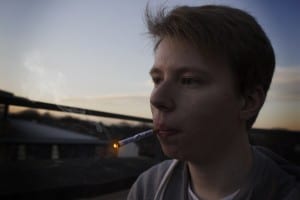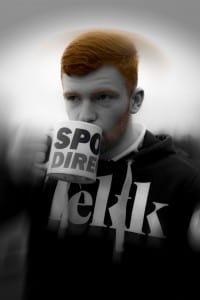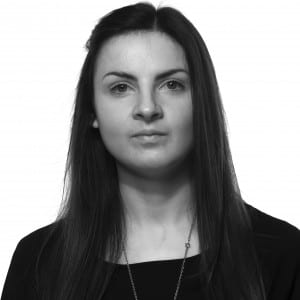For the 3rd brief, we were asked to take 3 pictures to demonstrate our ability to take portraitures. These must be a self-portraiture, a portraiture of a familiar person such has a roommate or mutual acquaintance and a stranger we find while we walk around, in order to build up some experience with working with strangers.
The main inspiration for my self-portraiture was a scene from the anime “Fooly Cooly”. In the scene below one of the characters, Mamimi Samejima is on a bridge alone at night after she was rejected by the main protagonist after she asked if he would spend time with her. She is shown smoking a cigarette with the words “Never Knows Best” written on the side. This little detail has always stood out to me in this scene ever since I’ve first seen it, and made me wonder about what the phrase means.
When the series director Kazuya Tsurumaki was asked about what the words mean he responded with “There’s a best way, and not everyone can follow it. No one knows the best way. I thought it reflected Mamimi’s belief that there’s no future. That it had a nuance that said she’s given up on life”. I really resonated with this idea that no one knows what the best thing to do in life especially since I watched this anime at a time in my life where I was deciding what I wanted out of life and what I thought would be best for me, so I wanted to pay homage to this scene which has helped shape my view of my future.
For my first attempt, I took the picture at sunset so I have the soft lighting of the “golden hour” and experiment with the angles of the shot to see what shot would work best.
This shot was the result I finished with. In photoshop I drained the saturation and vibrancy down to invoke more of a contrast with the burning of the cigarette’s glow but after showing my photography tutor she said the words were hard to read and the inclusion of a flash would brighten the image, however, I wanted the shadows to cast on the subject face evenly to give the impression of the sun setting and to add to the melancholic tone of the picture so I decided it would best not to manipulate the shadows and let them occur naturally. I experiment with the angle again this time using a lower one instead of a neutral angle as before to closer resemble the frame that I drew my inspiration from. I think this new angle works better has it shows the cigarette better, making it easier to read for the observer.
For my familiar portraiture, I drew inspiration from the photographer Robert Mapplethorpe and his famous black and white portraitures of famous celebrities and his self-portraits he did in the 1980s

What drew me to this style of photography was the contrast of black and white in the picture on a solid background which allows the viewer to focus on the details that may get lost in colour due to shading or shadows. Mapplethorpe aimed to aroused the observer through taboo and often controversial subjects such has the underground BDSM scene in the late 1960s and early 1970s in New York City. According to Patti Smith a long time friend of Mapplethorpe he “took areas of dark human consent and made them into art. He worked without apology, investing the homosexual with grandeur, masculinity, and enviable nobility. Without affectation, he created a presence that was wholly male without sacrificing feminine grace. He was not looking to make a political statement or an announcement of his evolving sexual persuasion. He was presenting something new, something not seen or explored as he saw and explored it. Robert sought to elevate aspects of male experience, to imbue homosexuality with mysticism. As Cocteau said of a Genet poem, “His obscenity is never obscene.”
I wanted to recreate this effect but I also experimented with the style by adding a single bold colour to stand out against the black and white background, making the subject unique to the environment around them. I chose to do this with the colour of the hair in particular as throughout different cultures your hair colour influences what type of personality you give the impression to others. An example of this is how blondes are portrayed as playful, youthful and energetic however slow-witted and ditzy in western media. For my familiar, I asked my flatmate for his picture but since I hadn’t seen him for a week due to him being on a reading week we mostly engaged in idle conversation about the time passed which I did on purpose to draw out his casual demeanour instead of a fake smile he usually puts on when someone takes his picture. I took the picture in colour and then made it black and white in editing with the exception of his red hair so it would stand out and draw attention to it from the viewer’s eye and give the impression of a warm friendly presence. The picture also has him taking a sip out of his coffee mug which adds a layer of dynamic movement to the image and makes him appear to be more relaxed and not posing for a camera. After showing this image to my tutor for feedback she said that image needs more to “evoking drama in the image from the posture and emotion in the subject.” She also suggested using a reflector to soft light the other side of the subject and using a lens with a wider aperture with the ISO being put one up.
I decide to look into another photographer to gain more inspiration for how to improve my familiar image and I can across Peter Lindbergh who is considered to be one of the most influential contemporary photographers today. He was influenced by Joseph Kosuth and the Conceptual movement which aligns with my project has I want to create an idea of the subjects within the images I take for this brief.

The image above is a portraiture of french actress Jeanne Moreau which he took for the magazine, Vanity Fair. Lindbergh says that “This should be the responsibility of photographers today to free women, and finally everyone, from the terror of youth and perfection.” I wanted to follow this philosophy too when I took my stranger and familiar and remove the pressure of wearing this false persona for the camera and let me capture them as they really are like with Moreau and how she has aged which he embraced in the photo. My first attempt with my roommate above however seems to lack and drama, making the image not very interesting or hold any deeper meaning aside from him drinking some coffee. For my second attempt, I asked my friend who was visiting me for his picture after explaining the brief to him to which he reluctantly agreed. What was different to me when asking for his photo he never looked at the camera and instead just kept talking about the changes in his life as with my flatmate he wanted to perform for the camera initially to which I had to defuse and tone him down. This is where I think the blank expression came from in the flatmate picture while with my second attempt my friend was so focused on what he was saying to me that he didn’t notice I took his picture. I tried to keep this tone of absent state of mind to show the viewer the subjects in an honest light instead of a false persona of a smile, too has Lindbergh would say, free them from that smile.
For my stranger portraiture, I took a photo of a member of staff from University. I took this photo while testing the lighting for my home project photos and asked this member of staff to help me set-up the lighting for the pictures, has I was having trouble remembering how to do it on my own. I got the distinct impression that this detail annoyed her so I wanted to capture that in the picture which comes through her expression has she did not smile out of reflex when she stood in from of the camera.
After looking at this photo I can see it is slightly overexposed in the background and it doesn’t capture what I wanted and I came to conclusion that the studio environment maybe the wrong choice if I wanted to capture people as they are as it is instinctive to pose or put on some form of facade in that environment. In response, I went back to being in the field and take another one of someone in the street just walking by me in a similar fashion to my final familiar photo. It was then I remember of a photo I took of one of the tutors who was covering for a workshop and I took the photo when she was explaining how lighting can influence an image and she seems to be very knowledgeable so I wanted to capture that moment. I then edited the photo by making it black and white and used a curves adjustment to create contrast similar to Mapplethorpe’s style of photography which I think I was able to achieve. If I were to take this photo again I would pay attention to the focus on the eyes as they are slightly out of focus which loses quality in the details of the face. After taking this feedback and the research I undertook I believed I have refined my skills in working in this area and with learning the differences between different types of subjects and I think this has come through in my final photos.
The final images can be viewed here.
Bilbography
Lindbergh, P. (2016). Biography. Available: http://www.peterlindbergh.com/biography. Last accessed 22th Mar 2017.
Smith, P (2010). Just Kids. United States: Ecco. p199.



Leave a comment